“The mind is like an ocean, with thoughts as waves on its surface. The deeper you dive in the ocean of the mind, the quieter and more settled it becomes.” —Dr. Tony Nader
Tony Nader, M.D., Ph.D., M.A.R.R., a medical doctor trained at Massachusetts Institute of Technology (Ph.D. in neuroscience) and Harvard University, and the head of the international TM organizations, granted permission to reprint excerpts from Chapter 11 of his new e-book, One Unbounded Ocean of Consciousness: Simple Answers to the Big Questions in Life (Penguin Random House, 2021). Order at DrTonyNader.com ►
Transcending, Pure Consciousness, and the Self
(Excerpts from Chapter 11)
If the truth about life—and existence itself—is that “Consciousness is all there is,” and if it makes sense to intellectually and conceptually support this assumption, is there a way to directly confirm this? We are conscious beings—shouldn’t we be able to confirm this from our own experience? Not just grasp it intellectually and conceptually, but “know” it through direct perception.
Yet in the three ordinary states of Consciousness, we do not seem to have direct access to this truth, if it is indeed the truth. In sleep, we are conscious of nothing. In dreams, we live vicariously in a world of illusory objects and fantastical events, with effortless superpowers such as flying over fields, mountains, and seas. Even in a waking state, what is it that we really know? Objects. Stuff. We live in a world of things and events—but where is Consciousness? We are conscious of the things we perceive, but not of Consciousness itself. Indeed, usually when we experience an object, the object dominates, and the experiencer falls into the background. Thus, for most people, the notion that “Consciousness is all there is,” is difficult precisely because it can seem counter to our lived experience.
However, many traditions, especially delineated with clarity in the Vedic tradition as brought to light by TM Founder Maharishi Mahesh Yogi, describe states of consciousness that are higher than the three “normal,” usual states of deep sleep, dream, and waking; higher states of consciousness in which we have greater experiential access to the truth of how things really are.
We live in a world of things and events—but where is Consciousness? We are conscious of the things we perceive, but not of Consciousness itself.
Higher States of Consciousness
. . . In this chapter, we will at last step into the fascinating and inspiring area of higher states of human evolution, particularly as described by Maharishi, the pre-eminent exponent of Vedic knowledge in our age. . . .
Despite the fact that enlightenment has been a major theme of spiritual teachings and philosophical rumination for centuries, it hasn’t been until recent decades that Western science has begun to consider that there can be substantially more to life than the daily cycle of wakefulness, sleep, and dreaming that are the full measure of reality for most people—more insight, creativity, capability, and happiness.

Tony Nader, M.D., Ph.D., M.A.R.R.
Starting with the unconscious, postulated by Freud, Jung, and other early-twentieth-century psychological thinkers, through the mid-century “Human Potential Movement” and its popularizing of peak experience, peak performance, the “flow” state, and other notions of optimum functioning, Western science has been moving in the direction of recognizing the higher capabilities of human being, knowing, and doing. One obvious reason for this opening to new horizons has been the increasing availability of Asian systems of knowledge, especially Buddhism and Yoga, and the teachings of the Vedas, from which, historically speaking, both Yoga and Buddhism are derived.
These ancient schools of thought and practice all have in common the understanding that there is an ultimate state of human psycho-spiritual evolution, with names such as enlightenment, Nirvana, Satori, Moksha, realization, self-realization, liberation, and so on, and on the path to this highest state, the aspirant passes through a succession of stages or levels of awakening. . . .
Some people have a real passion not only for growth, but also to attain the pinnacle of human awareness—the highest happiness, the greatest universal love, the supreme awakening. For them, the question of “enlightenment” is of far more than academic curiosity; it is a deep and compelling force motivating their lives. . . .
In our time, Maharishi, whose university training was in science before spending thirteen years of intensive focus on gaining enlightenment in service to a great spiritual master in the Himalayas, made a major contribution to human knowledge by pioneering the integration of the ancient Vedic knowledge of Consciousness with modern, objective scientific methodology. Since that time, of course, others have taken up the enterprise. Hundreds of books have been written and conferences convened to study and discuss the nature and evolution of Consciousness in the light of modern science.
Some people have a real passion not only for growth, but also to attain the pinnacle of human awareness—the highest happiness, the greatest universal love, the supreme awakening.
A central pillar of Maharishi’s comprehensive system of thought, which he called Maharishi Vedic ScienceSM, is a framework that offers clear definitions of each of seven states of Consciousness, as well as the procedures and practices that promote growth from one higher state to another. We will examine each of the seven states over the course of the next several chapters, but they are listed here for clarity:
1. Deep Sleep
2. Dream
3. Waking
4. The Transcendental State
5. Cosmic Consciousness
6. Glorified Cosmic Consciousness or God Consciousness
7. Unity Consciousness
One interesting way to think about the progressive unfoldment of Consciousness is in terms of the degree to which the object-value of awareness and attention predominates in a person’s experience, versus how much the subjective side—the observer—remains present and is not forgotten as one is experiencing a specific object. Keep this in mind as we discuss each of the seven states. . . .
Sleep, Dreaming, and Waking
Let’s start our exploration and analysis from the state of least consciousness, the inertia of deep sleep, and proceed through levels of increasing wakefulness to the fully awakened state of complete enlightenment.
We are all familiar with being awake, asleep, and dreaming. It’s about as fundamental an aspect of our lives as anything could be, and science has quite a thorough grasp of what goes on in our bodies and brains during these states.
Subjectively, when we are asleep, we have no experience of anything; there is no perception at all, no thinking, no sensory awareness—nothing. Physiologically, myriad processes of healing, refreshment, and rejuvenation are going on, but from the standpoint of Consciousness, there’s not much to talk about.
When we dream, we experience an often fantastical reality that could take us anywhere. Probably the most common term to describe the dream state is that it is “illusory”—from the perspective of physical reality, what happens in the dream state is simply unreal. Anything can happen. We may be exploring the surface of Mars, a tiger may be about to pounce, some thwarted waking-state desire may be getting fulfilled, but then we wake up and we say, “It was just a dream. It wasn’t real.” It had its own reality in the dream state, but that reality is different from the reality both of deep sleep, where nothing is happening, and the wakeful state. It is not transferable. That is, it takes a dream-state weapon to stop the pouncing dream-state tiger; a “real” rifle will not help, nor would a dream-state rifle avail for a real-world tiger.
Each state of consciousness is its own universe with its own rules. Or, as Maharishi used to emphasize, “Reality is different in different states of consciousness.”
As Maharishi used to emphasize, “Reality is different in different states of consciousness.”
When we sleep and when we dream, our bodies rest. But the apparent inertia is deceptive, as body and brain perform thousands of processes and adjustments, our biochemistry changes, our brain waves change according to whether we are asleep or asleep-and-dreaming, and the brain executes a kind of file management, sorting experiences into cognitive “file cabinets” of long- or short-term memory, or in some instances to be essentially deposited in the “trash” bin. Most of our sleep time (about 75 percent), is spent in deep, non-REM [rapid eye movement] sleep; the rest is dreamtime. [In sleep,] metabolism slows; temperature, blood pressure, and breathing rate decrease; muscles relax and become inactive. While dreaming, all these functions sometimes speed up again to correspond with what is happening in the dream, but the overall trend is for rest.
When we are awake, our senses are alive; we experience people and things that we knew before we went to sleep, and they “reappear” more or less the same. We have a baseline sense of who and what we are and of objects and unfolding events in our awareness. These objects can be the apparently solid, concrete items apprehended by the senses, or they can be thoughts, memories, plans, or entirely imaginary phenomena.
There is always something taking our attention. In the waking state of consciousness, we are always identifying our awareness with something: an object, a thought, a feeling, a process; and all of our Self is caught up in experiencing these phenomena. You look at a flower, and it’s the flower which captures your consciousness. . . .
The Observer is lost in the experience of objects as if the observer is obliterated, overshadowed, or annihilated by the experience of an object . . . The eighteenth-century Scottish philosopher David Hume poignantly described this condition:
“When I enter most intimately into what I call myself, I always stumble on some particular perception or other, of heat or cold, light or shade, love or hatred, pain or pleasure. I never can catch myself at any time without a perception, and can never observe anything but the perception.” —David Hume1
Because most people encounter exactly what Hume described when they look within themselves, the assumption has been made by most people that there is nothing else. This is a huge mistake. The mind is like an ocean, with thoughts as waves on its surface. The deeper you dive in the ocean of the mind, the quieter and more settled it becomes. The busy, object- and event-filled realm of the mind in the waking state is like swimming on the surface; far greater richness lies within. Nevertheless, what comments such as Hume’s effectively show us is that something different than just thinking needs to be done to experience Pure Consciousness.
. . . [This was introduced in] the middle of the last century when Maharishi brought to the world the simple technique of Transcendental Meditation and opened the door of enlightenment to millions of people, in a most effortless, natural way.
The busy, object- and event-filled realm of the mind in the waking state is like swimming on the surface; far greater richness lies within.
Transcending—Know Thyself
The first experience that is “more” than waking state awareness is the transcendental state, which may easily be experienced through the Transcendental Meditation technique. We close the eyes and allow the mind to go deeper into itself, guided by its own nature. Quite naturally it moves (the attention shifts) from a more objective, “concrete,” object-referral level of awareness to a more abstract, subjective level. The objects that were taking our attention fade away, and ultimately we arrive at the metaphorical screen that upholds the objects of perception, and that is our Self, our pure being, pure existence, beyond any limited experience.
To transcend means to “go beyond.” Thus, “transcendental” consciousness, in which one’s attention goes beyond the boundaries of thought and perception, is not an arbitrarily chosen designation, but a precise, descriptive term.
. . . ultimately we arrive at the metaphorical screen that upholds the objects of perception, and that is our Self, our pure being, pure existence, beyond any limited experience.
This is how Patanjali, the great sage who wrote Yoga Sutra, often referred to as the “textbook of Yoga,” described this experience: “Yoga is the complete settling of the activity of the mind. Then the seer is established in the Self . . . ” When mental activity decreases, then knower, knowing, and known become absorbed one into another. . . . all is calmed, and what remains is unbounded wakefulness. Wakefulness in this sense is “unbounded” in two ways.
First, the specific qualities of a perception, thought, or sensation in which awareness is temporarily limited or confined—a memory, a sound heard, chest rising and falling with each breath—all fade quietly away, leaving raw awareness itself.
Second, as TM practice continues, that pure awareness is found to be unbounded in space and time, beginningless and endless, an ocean of pure Being. This is the first time you really experience your Self. Before that, you know you are Mary and not Juliet, David and not Joseph, and there is a feeling, “it’s me.” But who you actually are, you do not know. If you look inside to find out, your mind goes through various notions, feelings, memories, conceptualizations, as in David Hume’s description above, but you have no grasp of the Self until you transcend.
So Transcendental Meditation—the form of meditation that effectively opens one’s awareness to the innermost core of one’s being—is a necessity for everyone, to at least know who you are. And what you discover is that what you are, in contrast to the ever-changing patterns of the sensory realms, is a field of silence and stability, a never-changing absolute state of pure awareness, pure consciousness. . . .
“Yoga is the complete settling of the activity of the mind. Then the seer is established in the Self.” —Patanjali, Yoga Sutra
Experiencing Pure Consciousness
. . . In the practice of TM, the meditator mentally repeats a mantra, a Vedic sound, in a prescribed way, such that it becomes increasingly subtle (quieter, fainter) and eventually fades to silence. It slowly dissipates, but the thinker, the person experiencing consciousness, remains. One perceives quieter states or levels of the thought and then transcends—goes beyond the thought to the Consciousness in which thoughts bubble up.
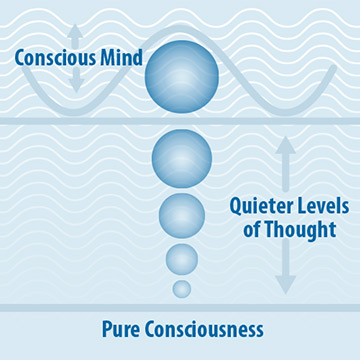
The experience of the true inner Self of everyone—Pure Consciousness—through the TM technique
. . . Transcendental Consciousness is found to be not “nothing,” but rather the source of all the intelligence and creativity displayed in our thoughts. Personal experience reveals it to be a field of infinite silence and unexpressed dynamism, unbounded in nature and blissful in the living of it.
“My Self is primarily identified with this enormous awareness,” one TM practitioner said, giving rather dramatic meaning to the term unboundedness: “I am struck by the fact that I feel huge, although I am physically small. I am going through my activity and feel just absolutely enormous, being more connected or identified with this expanded awareness than with my little, personal, individual characteristics.”
“During meditation, a profound, deep silence settles down after a while, which is beyond my description—just inner peace and contentment beyond time.” —V.K., TM practitioner
“I see the vast infinite field of Nothingness, without color, shape, texture, or distance. I see myself as a cosmic, silent witness outside our universe.” —D.G., TM practitioner
“During the practice, my awareness is characterized by bliss, light, unboundedness, lively dynamic silence, by which I mean the silence is permeated by a high-frequency vibration and flow, although there is also a non-moving quality.” —J.C., TM practitioner
One perceives quieter states or levels of the thought and then transcends—goes beyond the thought to the Consciousness in which thoughts bubble up.
The Fourth State: Transcendental Consciousness
Transcendental Consciousness, being the fourth state of Consciousness, is accordingly the first higher state of consciousness, and the “square one” prerequisite for the unfoldment of further stages of growth.
Large numbers of people have reported this transcending experience by means of the widespread TM technique, which is designed to facilitate the transcending process. Since the 1970s, thousands of TM meditators have been studied in university laboratories, using EEG and other modes of monitoring.2,3 The data clearly shows it is a unique state of Consciousness, in which people enjoy moments of pure awareness or pure Consciousness without the experience of any object except Consciousness itself, a state in which Consciousness is looking at its own Self.
This experience of “the Self” is somewhat similar to the common human experience of the sense of self or one’s identity. In common human experience, however, the self is experienced as separate from all other objects or content in awareness: “I know I am”; “I think, therefore I am”; “Know thyself”; and so forth. The transcendental pure awareness, on the other hand, is an experience of “the Self” as singularity. It is all there is.
The transcendental pure awareness . . . is an experience of “the Self” as singularity. It is all there is.
This is what some individuals throughout history describe as Samadhi, or Nirvana. It is a pure “spiritual” experience: “I experienced being conscious with nothing other than pure consciousness in my awareness.” These meditative states of awareness have been looked at philosophically and scientifically, with thousands of papers describing their effects on various physiological, psychological, and social parameters.
Thus, transcendence is a self-referral or self-referential state. Ordinary Consciousness is object-referral—our awareness is relating itself to some thought, some activity, perception, or unfolding event. Consciousness, as the subject, is attending to an object, whether internal (thought, feeling, image, memory, etc.), or to an external perception through the five senses; we are not aware that it is possible to be awake without any image, any thought, without anything other than wakefulness itself. The state that arises when all activity ceases, but you don’t fall asleep, is self-referral; all the ever-changing objects of ordinary perception drop away and what remains is a non-changing, pure, absolute state of awareness.
Transcendental Consciousness, being the fourth state of Consciousness, is accordingly the first higher state of consciousness, and the “square one” prerequisite for the unfoldment of further stages of growth.
© Copyright 2021, Tony Nader, M.D., Ph.D. All rights reserved. Do not reproduce without written permission of the author.
Order One Unbounded Ocean of Consciousness at DrTonyNader.com ►
Editor’s note: Read Chapters 12 and 13 to learn more about higher states of consciousness, from Cosmic Consciousness to Unity Consciousness, and watch for upcoming excerpts from Dr. Nader’s book in future issues of Enjoy TM News.
Find Dr. Nader’s talks on his Facebook page ►
Find Dr. Nader’s podcasts on iTunes ► Spotify ► SoundCloud ► and Google Play, Cashbox, and other platforms.
Notes


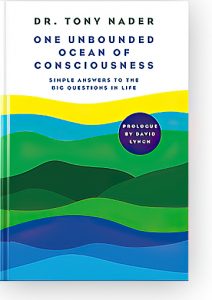
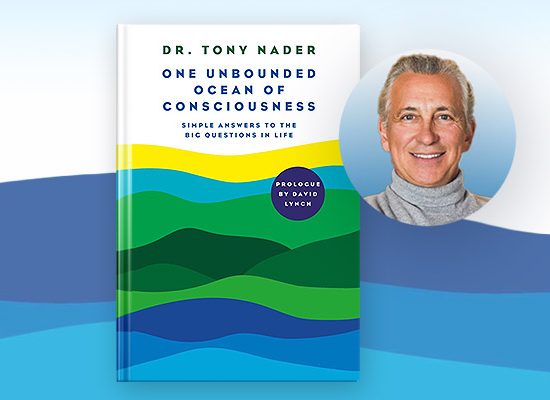

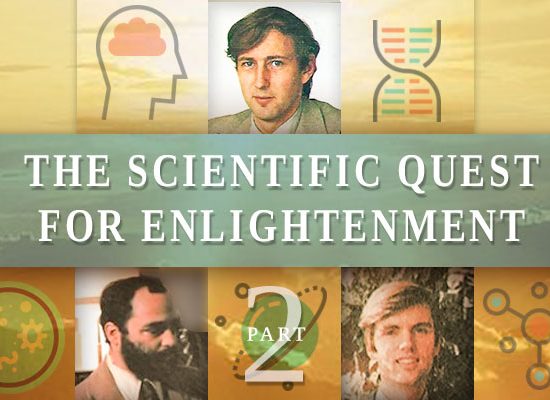
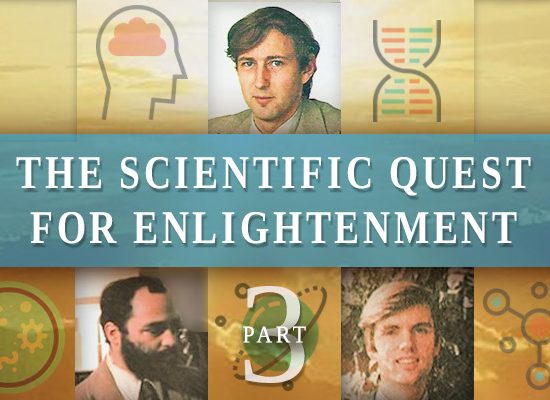
When will this book be on Audible format so I can listen to it.
I have no time to read and may never READ the book, but I would definitely listen to it.
Thanks, Carol, you’re not alone! There will definitely be an audio format for Dr. Nader’s book, and we’ll announce as soon as it’s available!